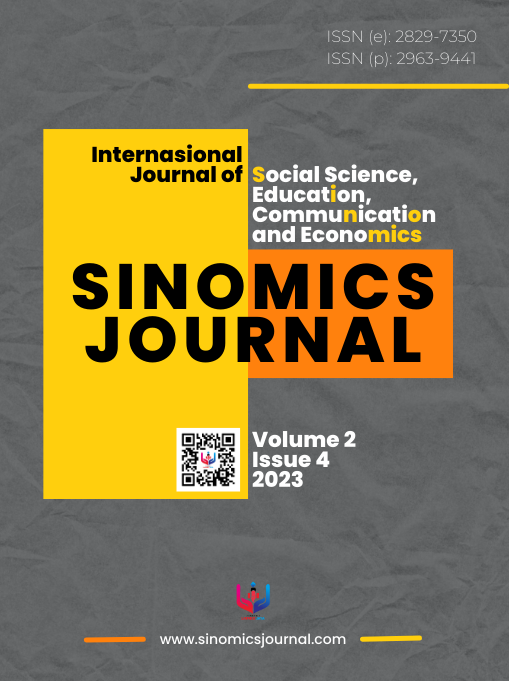The Affecting Electricity Consumption in Indonesia
Main Article Content
Elsa Fika Akhrani
Marselina
This research aims to analyze the factors that influence electricity consumption in Indonesia. The data used in this research is panel data for 2020-2022 in 32 provinces in Indonesia. The analysis technique used is Multiple Regression Analysis with Random Effect Model (REM). The dependent variable used is electricity consumption and the independent variables include electricity prices, income and number of customers. The research results show that the price of electricity has a negative and significant effect on electricity consumption. Meanwhile, income and number of customers have a positive and significant effect on electricity consumption. Simultaneously, electricity prices, income and number of customers have a significant effect on electricity consumption.
Agus Widarjono. (2018). Introductory Econometrics and its Applications Accompanied by Evies Guide. Fifth Edition. Yogyakarta.
Amri, A., & Iskandar, I. (2021). Causality of Per Capta Electricity Consumption and Per Capita GDP in Indonesia. Journal of Economics and Development, 12(1), 16–30.
Anggrasari. (1982). Price Elasticity, Cross Price Elasticity, Income Elasticity and Market Demand.
Ansari, MI (2017). BUMN and State Control in the Electricity Sector. Constitutional Journal, 14(1), 104.
Central Statistics Agency (BPS). (2022). Gross Regional Domestic Product Per Capita According to Provinces in Indonesia.
Ciptawaty, U., Aida, N., & Dhea Pratama, A. (2020). The Analysis of Economic Potential and Base Sector of Seven Provinces in Sumatra. Journal of Indonesian Applied Economics, 8(1), 8–12.
Darmayanti, Lail Putri. (2018). Analysis of the Relationship between Electricity Consumption and Economic Growth in Indonesia.
Faza, T. N., & Navastara, A. M. (2022). Factors that Influence Household Electrical Energy Consumption during the COVID-19 Pandemic (Case Study: Rusunawa in East Jakarta). ITS Engineering Journal, 11(2).
Gumelar, Galih. (2017). ESDM: National Electricity Consumption is Still a Quarter of Developed Countries.
Han, Sang-Yong. (2004). The Role of The Four Electric Power Sectors in Korean National Economy. Energy Police. 136-701.
Hanum, N. (2017). Analysis of the Influence of Income on the Consumption Behavior of Samudra University Students in Langsa City. 1(2), 107–116.
Hasid, Zamruddin. (2005). Analysis of electricity consumption in East Kalimantan. Jakarta: Trisakti University Economic Magazine.
Hasjanah, Kurniawati. (2022). Examining Efforts to Increase Electricity Consumption in Indonesia. IESR.
Himannudin, F., Marselina, M., Ratih, A., & Murwiati, A. (2022). Determinants of Gross Domestic Product in Southeast Asia. Klassen, 2(2), 126–140.
Indah Pratiwi, T. (2020). The Relationship between Electricity Tariffs, Electricity Consumption and Economic Growth in the South, Southeast and West Sulawesi Regions (Sulselrabar).
Johan, S., & Ari Mulianta Ginting. (2022). Determination of Electricity Consumption in Indonesia. Media Economics, 30(1), 106–117.
Kristianto, SI (2015). Analysis of Household Electricity Consumption in Tembalang District, 151, 10–17.
Nababan, E.Y., & Novester, A. (2022). Factors That Influence Consumer Demand for Electricity in Households. Trisakti Economic Journal, 2(2), 407–416.
Naufal, S., & Bambang E., A. (2021). Price Elasticity and Income Elasticity of Electric Energy Demand in Households in Indonesia. Journal of Socio Humanities Science.
Nilman, N., & Mintargo, M. (2020). Analysis of Household Electrical Energy Demand (Case Study: Households in Bengkulu City. Convergence: The Journal of Economic Development, 1(1), 39–55.
Nimala, T., Sri Waluyo, Moneyzar Usman, & Arivina Ratih. 2023 Rural Bio Energy: Efforts to Fulfill Alternative Energy Independently to Improve the Welfare of the Jati Sari Village Community. Indonesian Journal of Engagement, Community Services, Empowerment and Development, 3(1), 53–62.
Nur, Andi, C. 2010. Public Economics Module. Makasar State University.
Nuryati, N. (2022). Factors Affecting Electricity Consumption of Industrial Customers on the Island of Java. SECURITIES Journal (Stocks, Economics, Finance and Investment), 5(2), 169.
Mangkoesoebroto, Guritno. (2016). Public Economics. Yogyakarta: BPFE Yogyakarta.
Mulyani, D. Djoni Hartono. (2018). The Influence of Electrical Energy Efficiency in the Industrial and Commercial Sectors on Electricity Demand in Indonesia. Journal of Applied Quantitative Economics, 1(1), 1–7.
PT. PLN (Persero). (2020). 2020 Statistical Report. Jakarta.
PT. PLN (Persero). (2021). 2021 Statistical Report. Jakarta.
PT. PLN (Persero). (2021). 2021 Statistical Report. Jakarta.
Rahardja, Manurung. (2004). Macroeconomic Theory. Second Edition. Jakarta: Publishing Institute, Faculty of Economics, University of Indonesia.
Ridlo Al Hakim, R., Ropiudin, Muchsin, A., & Satya Lestari, F. (2021). Analysis of the Increase in Electricity Bills During the Covid-19 Pandemic Based on Electric Energy Consumptive Behavior in Indonesia. Cafeteria Journal, 2(1), 25–35.
Rosadi, Mutia & Syamsul Amar B. (2019). Factors That Influence Electricity Consumption in Indonesia. 1, 1–14.
Sukirno, Sadono. 2005. Introduction to Macroeconomic Theory. Jakarta: PT. Raja Grafindo Persada.
Sukirno, Sadono. (2013). Introductory Theory of Macroeconomics. Publisher PT. Raja Grafindo Persada, Jakarta.
William. (2002). Introduction to Economics, (Translated by Winardi). Bandung.
Yuliawan, D., & Wanniatie, V. (2021). Covid-19 Analysis of Micro, Small and Medium Enterprises (MSMEs) in Tulang Bawang Regency in 2020. Journal of Development Economics, 10(3), 144–158.










